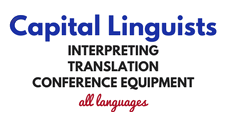- Set the level of service
First, assign the priority and level of services required. A good service level agreement ensures that the required interpreting and translation resources are available throughout the project. Service levels may specify the time frame, location, and availability of interpreters and translators. For example, the CITA may state that 2 Chinese conference interpreters will be available in-person and on-site on a specific day, and a Chinese translator will be available to give rush priority translations within 48 hours. Chinese conference interpreters who deliver simultaneous interpreting in Washington, DC, are often in high demand and short supply. Knowing the project’s specific requirements in advance allows us to prepare the best translation and interpreting resources.
2. Set the rates
Secondly, set the rates for the interpreting, translation, and conference equipment support services in the CITA. The rates depend on the language pair, the time duration of interpreting, word count for translation, and rental rates for translation and conference interpreting equipment. For example, Japanese to English translation and interpreting services may demand a higher rate on the market than English to Chinese services due to supply and demand.
3. Set the minimum qualifications
Thirdly, consider the interpreting and translation project requirements when setting the minimum required qualifications, background, and experience of the interpreters and translators in the CITA. For example, a Chinese court interpreting assignment may require a Chinese conference interpreter with a court interpreting certification, an advanced degree, and legal interpreting experience to provide simultaneous interpreting. A Korean translation assignment for a company may require a Korean translator with significant business experience.
4. Set the invoicing procedures
Fourthly, set the invoicing procedures and requirements in the CITA. For example, detail the due date, acceptable payment methods, and late penalties.
5. Create a budget
Fifthly, create a budget for all expenses in the CITA. For example, take into account the travel and transport fees, especially when delivering in-person and on-site interpreting services. The interpreters may require reimbursement for travel time. Of course, interpreters who travel to events and conferences may require reimbursement for flights, hotels, rental cars, food, and other expenses.
These 5 essential elements of CITA allow for effect project management for interpreting and translation assignments. Our translation company creates these agreements for the most effective project management and successful delivery of interpreting and translation services.
